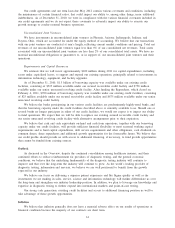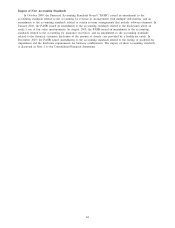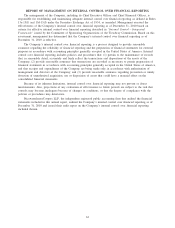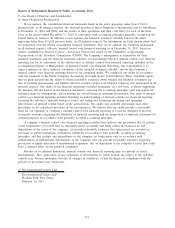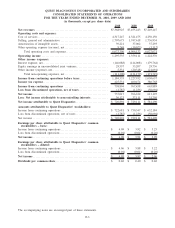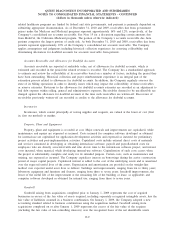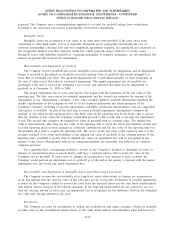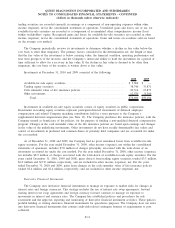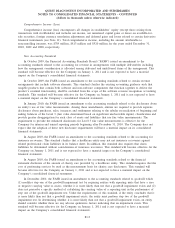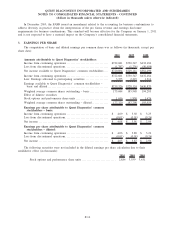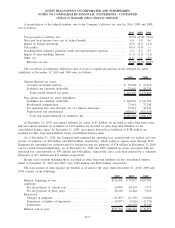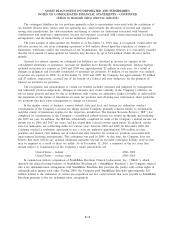Quest Diagnostics 2010 Annual Report Download - page 74
Download and view the complete annual report
Please find page 74 of the 2010 Quest Diagnostics annual report below. You can navigate through the pages in the report by either clicking on the pages listed below, or by using the keyword search tool below to find specific information within the annual report.number of performance share units expected to be earned is recognized as compensation cost in earnings in the
period of the revision. The Company recognizes stock-based compensation expense related to the Company’s
Amended Employee Stock Purchase Plan (“ESPP”) based on the 15% discount at purchase. See Note 13 for a
further discussion of stock-based compensation.
Fair Value Measurements
The Company determines fair value measurements used in its consolidated financial statements based upon
the exit price that would be received to sell an asset or paid to transfer a liability in an orderly transaction
between market participants exclusive of any transaction costs, as determined by either the principal market or
the most advantageous market. The principal market is the market with the greatest level of activity and volume
for the asset or liability. Absent a principal market to measure fair value, the Company has used the most
advantageous market, which is the market in which the Company would receive the highest selling price for the
asset or pay the lowest price to settle the liability, after considering transaction costs. However, when using the
most advantageous market, transaction costs are only considered to determine which market is the most
advantageous and these costs are then excluded when applying a fair value measurement.
Inputs used in the valuation techniques to derive fair values are classified based on a three-level hierarchy.
The basis for fair value measurements for each level within the hierarchy is described below with Level 1 having
the highest priority and Level 3 having the lowest.
Level 1: Quoted prices in active markets for identical assets or liabilities.
Level 2: Quoted prices for similar assets or liabilities in active markets; quoted prices for
identical or similar instruments in markets that are not active; and model-derived
valuations in which all significant inputs are observable in active markets.
Level 3: Valuations derived from valuation techniques in which one or more significant inputs
are unobservable.
Foreign Currency
The Company predominately uses the U.S. dollar as its functional currency. The functional currency of the
Company’s foreign subsidiaries is the applicable local currency. Assets and liabilities denominated in non-U.S.
dollars are translated into U.S. dollars at exchange rates as of the end of the reporting period. Income and
expense items are translated at average exchange rates prevailing during the year. The translation adjustments are
recorded as a component of accumulated other comprehensive income (loss) within stockholders’ equity. Gains
and losses from foreign currency transactions are included within other operating expense (income), net in the
consolidated statements of operations. Transaction gains and losses have not been material. For a discussion of
the Company’s use of derivative financial instruments to manage its exposure for changes in foreign currency
rates refer to the caption entitled “Derivative Financial Instruments – Foreign Currency Risk” below.
Cash and Cash Equivalents
Cash and cash equivalents include all highly-liquid investments with original maturities, at the time acquired
by the Company, of three months or less.
Concentration of Credit Risk
Financial instruments that potentially subject the Company to concentrations of credit risk are principally
cash, cash equivalents, short-term investments, accounts receivable and derivative financial instruments. The
Company’s policy is to place its cash, cash equivalents and short-term investments in highly-rated financial
instruments and institutions. Concentration of credit risk with respect to accounts receivable is mitigated by the
diversity of the Company’s payers and their dispersion across many different geographic regions, and is limited
to certain payers who are large buyers of the Company’s services. To reduce risk, the Company routinely
assesses the financial strength of these payers and, consequently, believes that its accounts receivable credit risk
exposure, with respect to these payers, is limited. While the Company has receivables due from federal and state
governmental agencies, the Company does not believe that such receivables represent a credit risk since the
F-8
QUEST DIAGNOSTICS INCORPORATED AND SUBSIDIARIES
NOTES TO CONSOLIDATED FINANCIAL STATEMENTS - CONTINUED
(dollars in thousands unless otherwise indicated)


